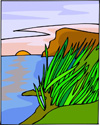Marine Communities |
 Water covers more than 75% of the Earth and 99% of that water is salt water. The marine biome is made up of salt water regions and includes estuaries, coral reefs, shores, and the open ocean. Life in marine communities is just as diverse as life in terrestrial communities and the organisms that live in marine communities must be adapted to live and survive under a wide variety of conditions. Water covers more than 75% of the Earth and 99% of that water is salt water. The marine biome is made up of salt water regions and includes estuaries, coral reefs, shores, and the open ocean. Life in marine communities is just as diverse as life in terrestrial communities and the organisms that live in marine communities must be adapted to live and survive under a wide variety of conditions.
Estuaries - Learn more about these coastal areas where freshwater from rivers and streams mixes with salt water from the ocean. Shores - Life at the seashore isn't a day at the beach for the organisms that live there! Ocean Zones - The open ocean makes up about 65 percent of ocean water and the organisms that live in this environment must be adapted to a wide variety of conditions. Plankton -This is where it all starts, plankton is the foundation of the ocean food web. Nekton- If it swims or moves on its own, it's a nekton! Squid and Octopus - From the same group as clams, these creatures have some unique adaptations that help them survive in the ocean. Bony Fish- Bony fish come in many shapes, sizes and colors, but they all have some things in common. Sharks and Rays - These efficient predators play an important role in the ocean food web. Dolphins, Porpoises and Whales - These ocean mammals that "talk" and "sing" are uniquely adapted for life in the water. Benthos: Life On the Ocean Floor - On the ocean floor you'll find a unique world! | Did You Know? ... that estuaries are called the nursery of the sea because many species of animals start life there. ... that estuaries are called the nursery of the sea because many species of animals start life there.
... that estuaries protect inland areas from flooding and storm damage. ... many estuaries are in danger from development. What Do You Think? Click here to test your marine communities knowledge. Click here to test your marine communities knowledge. NatureFiles
Teacher's Guide
View OnlinePatrice looks at how life in the ocean is organized in layers. Next, Patrice and Dave look at life in a tide pool. Then we take an up-close look at estuaries. Finally, Jessica and Daniel spend the day in an estuary at the Wells Reserve monitoring soft shell clams and green crab experiments with Caitlin Mullen and Lindsay Whitlow. Watch Online >>
|

 Learn more about marine animals.
Learn more about marine animals.